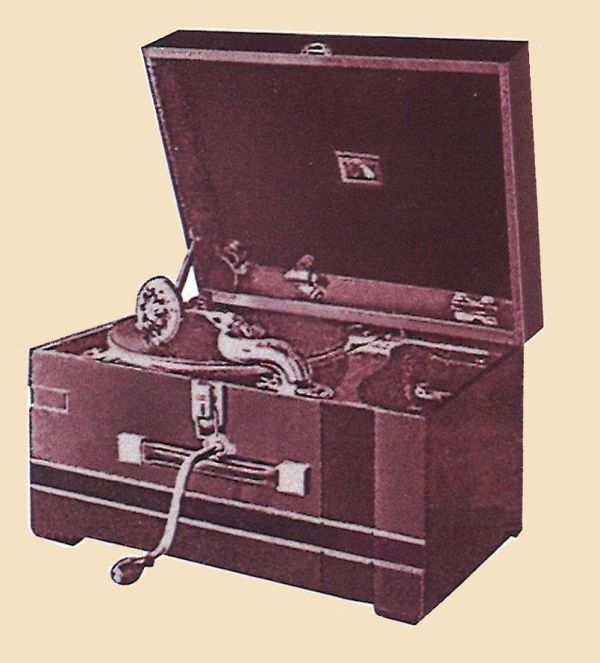HMV Portable Model 118
MANUFACTURER: Gramophone Company of India Ltd., Calcutta
MODEL: Portable model 118
SERIAL NO.:
YEAR: ca. 1936-1941
PRICE: 145 Rupees.
CASE: Highly polished Teak, tinted in mahogany with black embossed lines
TURNTABLE: 10 in./ 25 cm
HORN: internal, zinc-folded
MOTOR: HMV No. 32 double-spring with quadrant speed control
SOUNDOX: HMV No. 5B

The Gramophone Company of India Ltd. (a branch of the British Gramophone Company Ltd.), headquartered in Dum Dum, Calcutta, was founded about 1908 and produced phonographs and records for the Indian market. Buyers were primarily the British colonial rulers and wealthy Indians.
Characteristic for models of the indian market or production is the case that was usually made of teak and mahogany sporadically. Teak because it is very durable and weather-resistant and sensitive to environmental influences. It convinces with high strength and hardness.
The surface is a "high polished", which actually corresponds contrary to the usual "satin finish" on mahogany-machines with a pore-filled and high-glossy surface.
Most machines that turns up had a variable history. Many machines reached England with the former owners (British colonialists, the so-called Raj) during their return from India. That´s the reason why one finds these relatively rare models in England and occasionally in Holland.
Whether horn-, tablemodels, cabinet grands or portable gramophones - many models that belong to the standard range of the Gramophone Company in England or were produced in factories in Hayes, were also available in India. In addition, there are a few models that existed only in India or were there produced and sold by the Gramophone Company of India.
This includes the model 118 of the Gramophone Company of India shown below.
It is based on parts of the famous portable model 102 and was available from about 1936-1941. The arrangement on the engine board is also based on the model 102. However, it was unusual in that the case was opened lenghtways, instead of other portable models that opened on the short side or rather behind the opening horn.
As with other Indian models too, teak wood was used for the case and stained in mahogany. Notable are the sloped sides of the case as well as the "black bandings" on the front and the top of the case, as they are also found on other indian models like the models 94, 99, 102 and 114.
There is also a similar model from Columbia (Model 250).

Die Gramophone Company of India Ltd. (eine Tochter der britischen Gramophone company Ltd.) mit Sitz in Dum Dum, Calcutta, wurde ca. 1908 gegründet und produzierte Grammophone und Platten für den indischen Markt. Als Käufer kamen primär die britsichen Kolonialherren sowie wohlhabende Inder in Frage.
Charakteristisch für Geräte für den indischen Markt bzw. aus indischer Produktion ist, dass die Gehäuse in der Regel aus Teakholz und vereinzelt auch aus Mahagoni gefertigt wurden. Teak erklärt sich darin, dass Teakholz sehr robust und witterungsbeständig sowie unempfindlich gegen Umwelteinflüsse ist. Es verzieht sich auch bei wechselndem Klima kaum und überzeugt durch eine hohe Festigkeit und Härte. Die Oberfläche ist ein "high polished", was entgegen dem üblichen "Satin finish" tatsächlich einer porengefüllten und hochglänzenden Oberfläche entspricht.
Zumeist haben die Geräte eine wechselhafte Geschichte hinter sich. Viele Geräte sind mit den damaligen Besitzern (britischen Kolonialherren, die sog. Raj) von Indien nach England gelangt, weswegen man heute diese vglw. raren Modelle in England und vereinzelt in Holland vorfindet.
Egal ob Trichtergerät, Stand- oder Tischgerät oder Koffergrammophon - viele Modelle, die zum Standard-Sortiment der Gramophone Company in England gehören bzw. in den Fabriken in Hayes produziert wurden, waren auch in Indien erhältlich. Darüber hinaus gibt es einige wenige Modelle, die es ausschließlich in Indien gab bzw. dort durch die Gramophone Company of India produziert und vermarktet wurden.
Dazu gehört auch das nachstehend gezeigte Modell 118 der Gramophone Company of India Ltd.
Es basiert auf Teilen des bekannten Modells 102 und war von ca. 1936 bis 1941 erhältlich. Auch die Anordnung auf dem Motorboard orientiert sich an dem Modell 102. Das auffällige ist jedoch die Öffnung des Gehäuses auf der langen Seite, anstatt wie üblich bei allen anderen Koffermodellen auf der kurzen Seite bzw. hinter dem sich öffnenden Trichter.
Wie bei den indischen Modellen gängig, wurde hier für das Gehäuse Teak-Holz verwendet und farblich auf Mahagoni getrimmt. Auffällig sind die abgeschrägten Gehäuseseiten des Deckels sowie die sog. "black bandings" auf dem Gehäuse, wie sie auch bspw. bei den indischen Koffermodellen 94, 99, 102 und 114 zu finden sind.
Übrigens gibt es auch ein ähnliches Modell von Columbia, die nach der Fusion der HMV und der Columbia 1931 zur EMI wurde (Columbia Modell 250).

The motorboard of the model 118 with the autobreak No. 6, Quadrant speed control an the late Identification plaque
There are no Indian catalogues held in the EMI archives for the period 1928 and 1929 or between 1942 and 1955, so the following catalogue extract is really rare:

The indian portable model HMV 118 showed in an indian catalogue (ca. 1936-1941)
Source: The perfect portable by Dave Cooper, New Cavendish Books 2006
WRITTEN BY: The Symbol of Supremacy
Über Uns
Wir sind mehr als ein Forum! Als eingetragener Verein arbeiten wir an der Beständigkeit unserer Leidenschaft.
Über unsWir suchen Dich!
Du schreibst Artikel, möchtest im Forum als Moderator aktiv werden? Dir liegt Social Media. Bewahre Wissen! Wir warten auf dich.
Schreib unsTipps
Einsteiger-Ratschläge für optimale Nutzung und wichtige Aspekte beim Grammophon und Schellackplatten-Kauf.
Zu den Informationen




